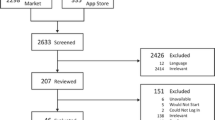Abstract
Background
Diabetes care in type 1 diabetes has remained a challenge over time. Ability to count carbohydrates in every meal and varying insulin dose according to individual insulin/carbohydrate ratio allows people with type 1 DM to have wider food choices with better glycemic control. Difficulties in carbohydrate counting may largely be solved by use of technology.
Methods
This work was done at the endocrine unit of a superspeciality centre involved in care of people with type 1 diabetes. The process of development of software and its preliminary application and results from its use in clinical care in a small group of interested patients is presented in this manuscript. Carbohydrate counting tool for Indian foods was developed, and subsequently, bolus dose calculation was automated by using the reinforcement algorithm in an android app platform named “T1-Life”. Data on app usability and acceptability is documented in this pilot study report.
Results
Five patients completed 3 months of this app usage. Among five people with combined usage over 115 patient weeks, a total of 2661 insulin dose predictions were made. This translates to 3.31 patient-initiated bolus dose predictions per day. Of the total bolus dose predictions made, 82% were accepted by the participants. With usage of app, time in range (70–180 mg/dl) increased by an average of 16.67% in children who used CGMS in their first week as well as last week of observation.
Conclusion
T1-life, integrated carbohydrate counting and reinforcement-based insulin bolus dose prediction system, has good patient usability and acceptability.


Similar content being viewed by others
References
Kumar P, Krishna P, Reddy SC, Gurappa M, Aravind SR, Munichoodappa C. Incidence of type 1 diabetes mellitus and associated complications among children and young adults: results from Karnataka Diabetes Registry 1995-2008. J Indian Med Assoc. 2008;106(11):708–11.
Kalra S, Kalra B, Sharma A. Prevalence of type 1 diabetes mellitus in Karnal district, Haryana state, India. Diabetol Metab Syndr. 2010;2:14.
Kumar KMP. Incidence trends for childhood type 1 diabetes in India. Indian J Endocrinol Metab. 2015;19(Suppl 1):S34–5.
Kahkoska AR, Shay CM, Crandell J, et al. Association of race and ethnicity with glycemic control and hemoglobin A levels in youth with type 1 diabetes. JAMA Netw Open. 2018;1(5). https://doi.org/10.1001/jamanetworkopen.2018.1851.
Niba LL, Aulinger B, Mbacham WF, Parhofer KG. Predictors of glucose control in children and adolescents with type 1 diabetes: results of a cross-sectional study in Cameroon. BMC Res Notes. 2017;10(1):207.
Schoenaker DAJM, Simon D, Chaturvedi N, Fuller JH, Soedamah-Muthu SS. EURODIAB Prospective Complications Study Group. Glycemic control and all-cause mortality risk in type 1 diabetes patients: the EURODIAB prospective complications study. J Clin Endocrinol Metab. 2014;99(3):800–7.
Unnikrishnan AG, Bhatia E, Bhatia V, et al. Type 1 diabetes versus type 2 diabetes with onset in persons younger than 20 years of age. Ann N Y Acad Sci. 2008;1150:239–44.
Agiostratidou G, Anhalt H, Ball D, et al. Standardizing clinically meaningful outcome measures beyond HbA for type 1 diabetes: a consensus report of the American Association of Clinical Endocrinologists, the American Association of Diabetes Educators, the American Diabetes Association, the Endocrine Society, JDRF International, The Leona M. and Harry B. Helmsley Charitable Trust, the Pediatric Endocrine Society, and the T1D Exchange. Diabetes Care. 2017;40(12):1622–30.
Schmidt S, Schelde B, Nørgaard K. Effects of advanced carbohydrate counting in patients with type 1 diabetes: a systematic review. Diabet Med. 2014;31(8):886–96.
Fu S, Li L, Deng S, Zan L, Liu Z. Effectiveness of advanced carbohydrate counting in type 1 diabetes mellitus: a systematic review and meta-analysis. Sci Rep. 2016;6:37067.
Bell KJ, Barclay AW, Petocz P, Colagiuri S, Brand-Miller JC. Efficacy of carbohydrate counting in type 1 diabetes: a systematic review and meta-analysis. Lancet Diabetes Endocrinol. 2014;2(2):133–40.
Hommel E, Schmidt S, Vistisen D, et al. Effects of advanced carbohydrate counting guided by an automated bolus calculator in type 1 diabetes mellitus (StenoABC): a 12-month, randomized clinical trial. Diabet Med. 2017;34(5):708–15.
Website. Accessed December 26, 2019. Herrero, Pau, López, Beatriz, & Martin, Clare. PEPPER: patient empowerment through predictive personalised decision support. Zenodo. 2016. https://doi.org/10.5281/zenodo.427542.
Patient empowerment through predictive personalised decision support (PEPPER)-validation study. - Tabular View - ClinicalTrials.gov. Accessed December 26, 2019. https://clinicaltrials.gov/ct2/show/record/NCT03849755
Pesl P, Herrero P, Reddy M, et al. An advanced bolus calculator for type 1 diabetes: system architecture and usability results. IEEE J Biomed Health Inform. 2016;20(1):11–7.
Pesl P, Herrero P, Reddy M, et al. Case-based reasoning for insulin bolus advice. J Diabetes Sci Technol. 2017;11(1):37–42. https://doi.org/10.1177/1932296816629986.
Bozzetto L, Giorgini M, Alderisio A, et al. Glycemic load versus carbohydrate counting for insulin bolus calculation in patients with type 1 diabetes on insulin pump. Acta Diabetol. 2015;52(5):865–71.
Battelino T, Danne T, Bergenstal RM, et al. Clinical targets for continuous glucose monitoring data interpretation: recommendations from the international consensus on time in range. Diabetes Care. 2019;42(8):1593–603.
Beck RW, Bergenstal RM, Cheng P, et al. The relationships between time in range, hyperglycemia metrics, and HbA1c. J Diabetes Sci Technol. 2019;13(4):614–26.
Vigersky RA, McMahon C. The relationship of hemoglobin A1C to time-in-range in patients with diabetes. Diabetes Technol Ther. 2019;21(2):81–5.
Acknowledgment
Contributions of Amit Lahoti and Vineet Surana are acknowledged for their valuable inputs towards study design and analysis of data.
Author information
Authors and Affiliations
Contributions
R.S., G.G., J.B., and A.S. performed the research. R.S., A.S., and Y.G. designed the research study. R.S., J.B., S.A., and A.S. analysed the data. R.S., J.B., and Y.G. wrote the paper. All authors critically edited and endorsed the manuscript.
Corresponding author
Ethics declarations
Ethics approval
This study was carried out as part of routine clinical care and is automation of clinical care of type 1 diabetes participants. Data was collated retrospectively.
Conflict of interest
The authors declare no competing interests.
Additional information
Publisher’s note
Springer Nature remains neutral with regard to jurisdictional claims in published maps and institutional affiliations.
Rights and permissions
About this article
Cite this article
Singla, R., Bindra, J., Singla, A. et al. Automation of insulin bolus dose calculation in type 1 diabetes: a feasibility study. Int J Diabetes Dev Ctries 43, 66–71 (2023). https://doi.org/10.1007/s13410-022-01054-7
Received:
Accepted:
Published:
Issue Date:
DOI: https://doi.org/10.1007/s13410-022-01054-7




